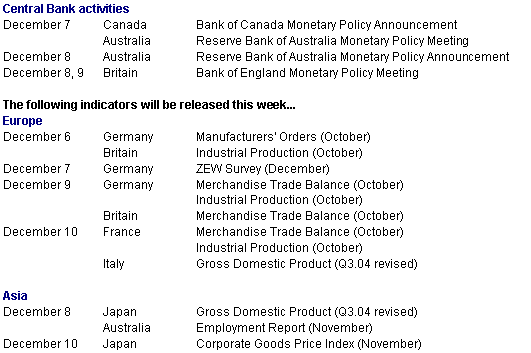Monday, December 6, 2004

ECB first of many to meet in December
The European Central Bank met Thursday and left their key interest rate at 2 percent. This was no surprise - unemployment and inflation remain high and growth is anemic. The euro's strength against the dollar is an important factor in the interest rate equation - higher interest rates would likely strengthen the euro even more. Since the November ECB monetary policy meeting, the euro has risen over 4 percent. This has prompted ECB President Jean Claude Trichet to warn that recent foreign exchange gyrations have been both "brutal" and "unwelcome". During the press conference that followed the meeting, there was no indication that the governing council had considered a rate cut to help the struggling economies. Rather they considered raising rates amid concerns of rising inflation. Generally, a stronger currency reduces the cost of imports, thereby dampening inflation. But despite the rhetoric, analysts believe that the ECB will not be increasing rates soon.
Oil prices slip and equities celebrate
Equities in Asia and Europe celebrated easing crude oil prices. Prices for London Brent crude - the benchmark price used in international markets - dropped below the $40 mark for the first time in three months after a larger-than-expected increase in U.S. crude stocks helped soothe fears of a winter supply squeeze. Analysts also attributed the decline to mild winter weather so far, which has tempered heating oil demand. The drop in oil prices also helped to ease persistent investor jitters over the impact of energy costs on company profits and economic growth. However, traders warned that the drop could come to a screeching halt if there is a cold snap in North America or any major supply problems reemerge elsewhere.
The dollar continues to be pounded
The dollar continues to hit new lows against the euro with increasing frequency, and events over the past two weeks have only contributed to investors' already bearish outlook for the currency. First, Fed Chairman Alan Greenspan said he expected a weaker dollar to be the main route by which the U.S. current account deficit will be reduced. Then the G20 meeting of rich and developing countries made no statement about exchange rates, indicating coordinated intervention to support the dollar was highly unlikely. Then on Friday, the employment report disappointed one and all when jobs increased at a rate lower than the lowest forecasts. In theory, the falling dollar should encourage U.S. exports and may even help EMU equity markets, since it should persuade the European Central Bank to keep interest rates lower than they would otherwise have been. But lurking in the background is uncertainty about crude oil prices and whether the very recent decline in prices is sustainable given the unpredictability of the weather and political uncertainties in major oil-producing regions.
The longer-term fear is that the dollar's decline could get out of control. Every new low represents a hit to the portfolios of overseas investors that own U.S. securities. Asian investors who are protected by a dollar peg have yet to feel any pain. But the longer the Asians fund the U.S. current account deficit by buying U.S. securities, the bigger their stake becomes and the greater the potential losses if the peg is broken.

The pound sterling surged to its highest level against the dollar since Black Wednesday, September 16th 1992. This is when the currency crashed out of the Exchange Rate Mechanism, the prototype for the euro, despite the Bank of England having spent �7 billion of its reserves to support it. The pound was aided by rising PMI surveys for manufacturing and services that looked particularly strong when compared with the EMU's dismal performance. These data added to sterling-positive news on Tuesday when: Bank of England Governor Mervyn King gave an upbeat assessment of the economy, the Organization for Economic Co-operation and Development said three interest rate increases were needed in 2005, and housing and retail sector data, like the PMIs, beat expectations. On Friday afternoon, the pound sterling was trading above $1.94.
The dollar continues to slide against the yen, but not quite as drastically. Traders are more cautious because the Japanese finance ministry does not hesitate to intervene when they feel the yen is appreciating to unacceptable levels.
Equities continue to climb
While global markets followed here all posted good gains in November, the U.S. employment report on Friday changed some of those gains to losses. The report disappointed as employment growth returned to a weak growth pattern. This was exacerbated by downward revisions to both the September and October data. Although Asia/Pacific markets had long gone to bed for the week, indexes in Europe did an about face. What was up prior to the U.S. report sank. Equity investors were not the only ones to take a dim view of the data, currency market traders, who are quick to slam the dollar these days, sold the currency. The dollar continues to be the investors' focal point as the rhetoric picks up on both sides of the world. On the week, 12 of 13 indexes improved on the previous week. The Toronto S&P/TSX composite slipped 2.3 points.
Global Stock Market Recap

Europe and Britain
Stocks in Europe and Britain continued November's winning ways into the first two days of December trading. The indexes sagged, however, on the disappointing U.S. employment data. Companies most dependent on revenue from exports declined, including Volvo and Nokia. The indexes pared declines after the U.S. services PMI index was up more than forecast. Investors were relieved by the easing of crude oil prices after U.S. inventories proved to gain more than expected. Following what has become an established pattern, European investors trade on U.S. data given fragile European economies and their dependence on exports to the U.S. Anything that might impact U.S. consumption is an investor negative. The FTSE, DAX and CAC were up on the week and are all up slightly more 6 percent on the year.

Asia/Pacific
Asian/Pacific shares began the last month of 2004 in good spirits. The six indexes followed here were up in both November and last week. Lower crude oil prices combined with favorable data on U.S. consumers helped buoy investors. Japanese stocks were up despite weak domestic economic data (see indicator scoreboard below). Markets in Asia/Pacific were closed for the weekend long before U.S. employment data were released and will have the benefit of observing market action elsewhere before making their investment decisions.

In Japan, data are noticeably weaker. The latest show that industrial production has declined while the unemployment rate has increased. The decline in industrial production was underlined by Japan's manufacturers PMI survey. Demand from both domestic and overseas customers deteriorated in November. New export orders fell for the first time in 18 months thanks to the global economic slowdown, but specific reference was also made to reduced demand out of China for manufactured goods.
Indicator scoreboard
EMU - M3 money supply for the three months ending in October was up 5.8 percent when compared with the same three months in 2003. Although the rate of growth far exceeds the ECB's 4.5 percent target, it is not currently given much weight in policy decisions.

November flash harmonized index of consumer prices was up 2.2 percent when compared with last year, somewhat lower than October's 2.5 percent jump. Details are not available for the flash release but it is likely that easing oil prices in November are reflected in the data.
November manufacturing purchasing managers' index dropped to 50.4 from 52.4 in October. An index reading above 50 signals expansion and below 50, contraction. New orders declined for the first time since August 2003. Both German and Italian manufacturing sectors contracted with readings of 49.9 and 48.1 respectively. In contrast, growth in both the U.S. and British manufacturing sectors accelerated in November.

November services purchasing managers' index declined to 52.6 from 53.5 in the previous month. Although still above the 50 no-change level, the rate of increase was the weakest in 15 months. The rate of growth slowed in Germany, France and Italy. The composite output index, which measures the output of the combined manufacturing and service sectors, dropped from 53.7 to 51.7 in November. The indexes in Britain and the U.S., however, showed an acceleration of growth.

October seasonally adjusted unemployment rate remained at 8.9 percent for the 20th month in a row. Of the nine countries reporting October data, the unemployment rate rose in one, fell in four and was unchanged in four. Eurostat estimated that 12.7 million men and women were unemployed in the eurozone.

Third quarter real gross domestic product was up 0.3 percent and 1.9 percent when compared with the same quarter a year ago. Growth was due entirely to domestic demand (especially inventories). Private consumption growth was up 0.2 percent - the same as in the second quarter. However, gross fixed capital investment was up 0.6 percent - double that of the second quarter.

EU - November economic sentiment index slipped to 100.8 from 101.3 in October. Industrial sentiment remained at minus 3 while consumer sentiment moved to minus 13 from minus 14 in the previous month. However, services sentiment eased to plus 10 from plus 12 while retail sentiment fell to minus 9 from minus 7. The overall index was unchanged for Germany and Italy, was up in Spain, but dropped in France and most other countries.

Germany - Third quarter preliminary gross domestic production was up 0.1 percent and 1.3 percent when compared with the third quarter in 2003. A sharp increase in domestic demand thanks to higher inventories barely offset a sharp deterioration in net exports. However, the increase in inventories should be viewed with caution because this category also contains statistical remainders. Consumer spending was flat but total investment was up 1.3 percent on the quarter with equipment investment jumping 4.1 percent.

November Ifo Institute business sentiment index dropped to 94.1 from 95.3 in October. The November level was the lowest since September 2003. Current conditions declined to 93.8 from 94.7 while future expectations sank to 94.3 from 95.9 in the previous month. Business climate was down in manufacturing, wholesale and retail sectors while construction was unchanged, albeit at a very low level.

October total retail sales were up 2.3 percent but down 1.3 percent when compared with last year. Excluding autos and gasoline stations, sales were up 1.6 percent but down 3.7 percent on the year. Excluding only autos, sales were up 1.6 percent but down 1.1 percent on the year.
November seasonally adjusted pan-German unemployment was up by 7,000 - 3,000 in the west and 4,000 in the east. As a result, the pan-German unemployment rate inched up to 10.8 percent from 10.7 percent in October. West German unemployment rate remained at 8.6 percent while east Germany's unemployment rate climbed to 18.8 percent from 18.7 percent in the previous month. September seasonally adjusted employment was down by 1,000. The employment data lag unemployment data by two months.

France - October producer price index jumped 0.6 percent and 3.5 percent when compared with last year. Core PPI, excluding food and energy, was up 0.2 percent and 2.2 percent on the year. The jump was fueled by the renewed climb in oil prices. Energy prices soared 3.1 percent and 11.9 percent on the year. However food and agriculture prices were down on the month.
October seasonally adjusted consumer spending on manufactured goods jumped 0.9 percent and 2.1 percent when compared with October 2003. Clothing and household durables were cited for the increase, up 3 percent and 2.3 percent respectively.

October seasonally adjusted unemployment rate remained at 9.9 percent despite a 5,000 person decline in the number of jobless. Unemployment is defined according to the International Labour Organization which excludes jobseekers who did any work during the month.

Britain - Third quarter gross domestic product growth slowed to 0.4 percent and 3.1 percent when compared with the same quarter a year ago. Second quarter GDP in contrast had been up 0.9 percent and 3.6 percent on the year. Household spending was up 0.5 percent and 3 percent on the year, somewhat lower than growth in the second quarter. Gross fixed capital formation edged down 0.1 percent and was up 6 percent on the year. However, government expenditures were up 1.4 percent and 4.7 percent on the year.

Asia
Japan - September tertiary index was up 0.1 percent and 1.3 percent when compared with last year. The index is a gauge of service industry activity. A record number of typhoons, including two in September, curbed the gains by disrupting transportation and travel. The all-industry index was down 0.1 percent but was up 1.6 percent on the year. The all industry index combines the tertiary index with activity in construction, agricultural and fisheries industries, the public sector and industrial output. This index is considered a close approximation for gross domestic product growth as measured by industrial and service sector output. Within the tertiary industry index, the restaurants and leisure sector gained 3.3 percent on the month.
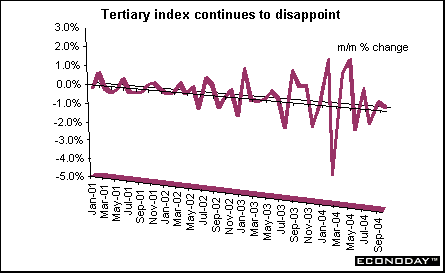
October seasonally adjusted merchandise trade surplus was �860 billion. Exports were up 3.2 percent while imports were up 2.7 percent. Exports to the U.S. grew 3.4 percent from a year earlier, and shipments to the European Union gained 10.8 percent. Exports to Asia expanded 12.6 percent.
November Tokyo consumer price index was down 0.1 percent but was up 0.6 percent when compared with last year. Core Tokyo CPI was down 0.2 percent and dropped 0.3 percent on the year. October nationwide CPI was up 0.5 percent both on the month and on the year. Core CPI was unchanged on the month and slipped 0.1 percent on the year. Cheaper rice and discounts on computers offset higher oil costs. The Bank of Japan has vowed to keep pumping cash into the world's second-largest economy to keep interest rates at almost zero until core consumer prices stop falling and policy makers are sure declines won't resume.

October seasonally adjusted industrial production sank 1.6 percent but was up 1.4 percent when compared with October 2003.
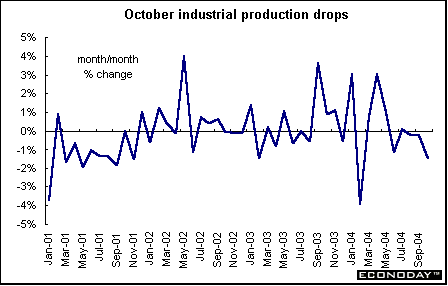
October unemployment rate inched up to 4.7 percent from 4.6 percent in September. A total of 210,000 people left the workforce, while the economy shed 260,000 jobs.
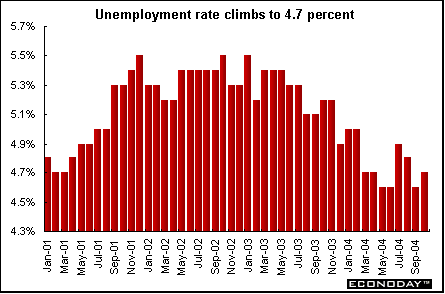
October spending by households headed by wage earners dropped 1.0 percent but was up 0.1 percent from a year earlier. Wage earner household spending is an important gauge of personal consumption, which makes up roughly 55 percent of Japan's gross domestic product. The propensity for wage earner households to consume, a ratio that measures the amount of disposable income that went to household spending, rose to 72.6 percent from 71.6 percent in September.
Australia - Third quarter gross domestic product increased 0.3 percent and was up 3 percent when compared with the same quarter a year ago. The third quarter result was the slowest growth rate since the economy contracted in the fourth quarter of 2000. A decline in business inventories subtracted 0.7 percentage points from growth in the quarter. Government spending increased 1.5 percent in the third quarter from the previous three months. Consumer spending rose 1.1 percent in the third quarter from the previous three months.
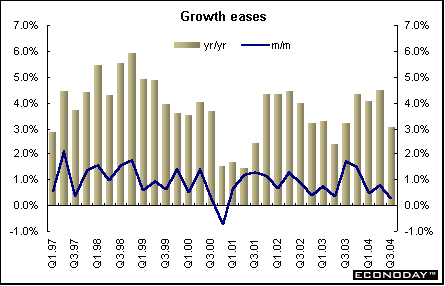
Americas
Canada - October consumer price index was up 0.2 percent and 2.3 percent when compared with last year. The CPI excluding food and energy was unchanged on the month and up 1.0 percent on the year. On the year, gasoline prices were up 20.3 percent after jumping 7.2 percent in September. Fuel oil prices soared 38.4 percent. Other prices, including homeowner replacement and cigarette prices, also were up. Prices were down for auto leasing, computer equipment and traveler accommodations. October seasonally adjusted CPI was up 0.4 percent and 2.4 percent while the core CPI was up 0.1 percent and 1.1 percent on the year.
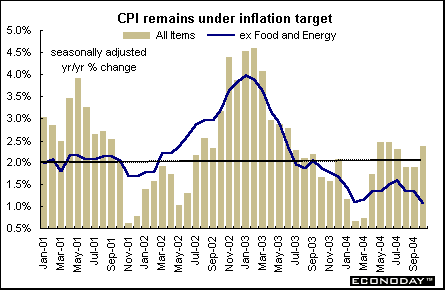
Third quarter gross domestic product was up 0.8 percent and 3.3 percent when compared with the same quarter a year ago. In the third quarter, domestic demand was up 0.8 percent, government spending was up 1 percent and business investment jumped 2 percent. Corporate profits were up 2.1 percent, down significantly from the pace of the first two quarters.

October industrial product price index dropped 0.5 percent but was up 5.4 percent when compared with October 2003. The IPPI has declined on a monthly basis in four of the last five months. On the year, prices for petroleum and coal products continue to have a major impact, jumping 38.6 percent in October. If petroleum and coal product prices had been excluded, the IPPI would have increased only 3.0 percent.
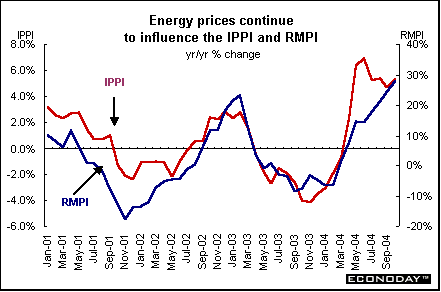
October raw material price index jumped 3.8 percent and 28 percent when compared with last year. On the year, mineral fuels soared 52.5 percent while crude oil prices vaulted by 68 percent. If both had been excluded the RMPI would have increased only by 8.8 percent on the year.
In October, the Canadian dollar strengthened against the U.S. dollar by 3.2 percent. If the impact of the exchange rate had been excluded, the IPPI would have risen 0.4 percent compared with the actual 0.5 percent decline. On the year, if the impact of the exchange rate had been excluded, prices would have risen 7.0 percent rather than their actual 5.4 percent increase.
November employment climbed by 4,600 jobs and the unemployment rate jumped to 7.3 percent from 7.1 percent in the previous month. Unemployment was up due to the 35,800 persons who entered the labor force during the month. The participation rate edged up by 0.1 percent to 67.5 percent. The number of jobs declined in manufacturing (down 18,000) and accommodations (down 13,000). However, the finance, insurance, real estate and leasing category jumped by 21,000 jobs, educational services category gained 15,000 jobs and retail and wholesale, 11,000 jobs.
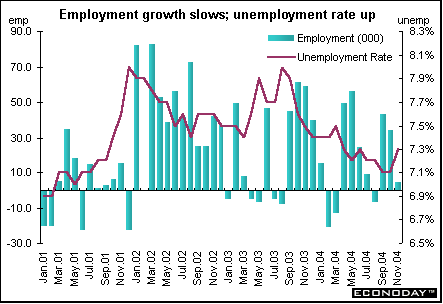
Bottom line
With several central bank meetings this week, investors will be looking for any comments relating to the plunging value of the dollar. Traders continue to sniff around trying to find the "line in the sand" where intervention would occur. On Friday afternoon, the dollar was propelled lower on comments from a German official who quoted a Treasury official saying the U.S. would only buy dollars if the euro rose above $1.45. The ECB cannot afford to intervene without a concerted effort on the part of others, namely the U.S. It cannot afford to fail - it is still the new bank on the block.
Looking Ahead: December 6 through December 10, 2004
